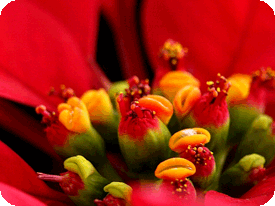Poinsettia Day
Care & Feeding
Poinsettias are NOT poisonous, that is a myth, however, people sensitive to latex, the milky fluid found in cut poinsettias and other plants, may experience irritation in the form of a rash if they come in contact with the sap.
The poinsettia's flowers are the brightly colored buds in the plants middle. So it's the leaves, or bracts, that give the plant its color. In nature, Poinsettias are perennials that can grow to ten feet.
Choose plants with firm stems, and no signs of wilting, breaking or drooping. Poinsettias need space to flourish, so be extra careful picking plants from a store where they're crowded into a display. Avoid waterlogged soil, especially if the plant is wilted. That could indicate irreversible root rot. Keep the plant protected from winds and temperatures below 50°F (10° C). The plant should be 2-1/2 times taller than the diameter of the container.

Place your poinsettia in a sunny window. Temperatures of 60-70°F are ideal (15.5°-21°C ). Water when the soil is dry. Do not fertilize while the plant is blooming.
If you cut your poinsettia for a flower arrangement leave at least four inches of stem. Seal the cut end by dipping in boiling water or holding over a flame for fifteen seconds.
You can save your poinsettia for re-blooming. In late March or early April cut your poinsettia back to about 8" in height. Water regularly and fertilize with a good all-purpose fertilizer. Place your plants outdoors in the spring after you're sure of maintaining an average overnight temperature of at least 55°F (13°C ). In late June or early July prune your plant to keep it bushy and compact. In early June you may transplant your poinsettia to a larger pot or into the garden. A soil mix with a good amount of peat moss or other organic matter is recommended.
The poinsettia requires long dark autumn nights in order to bloom. Starting October 1, the plant must be in complete darkness each night. Light such as street lamps can delay or entirely halt the re-flowering process. If necessary cover your plant with a box or light-proof bag between 5pm and 8am. Continue regular waterings and fertilize every 2-3 weeks. You should see a colorful blooms for Christmas.
One of the Christmas Poinsettias I'm trying grow out into a tree recently developed a fungal infection. I was surprised and delighted to discover a new resource for Poinsettia care that includes details of various plant diseases the Poinsettia is prey to. You can find it at PlantManagementNetwork.org.

